lock HYUNDAI COUPE 2014 Owners Manual
[x] Cancel search | Manufacturer: HYUNDAI, Model Year: 2014, Model line: COUPE, Model: HYUNDAI COUPE 2014Pages: 546, PDF Size: 14.38 MB
Page 7 of 546
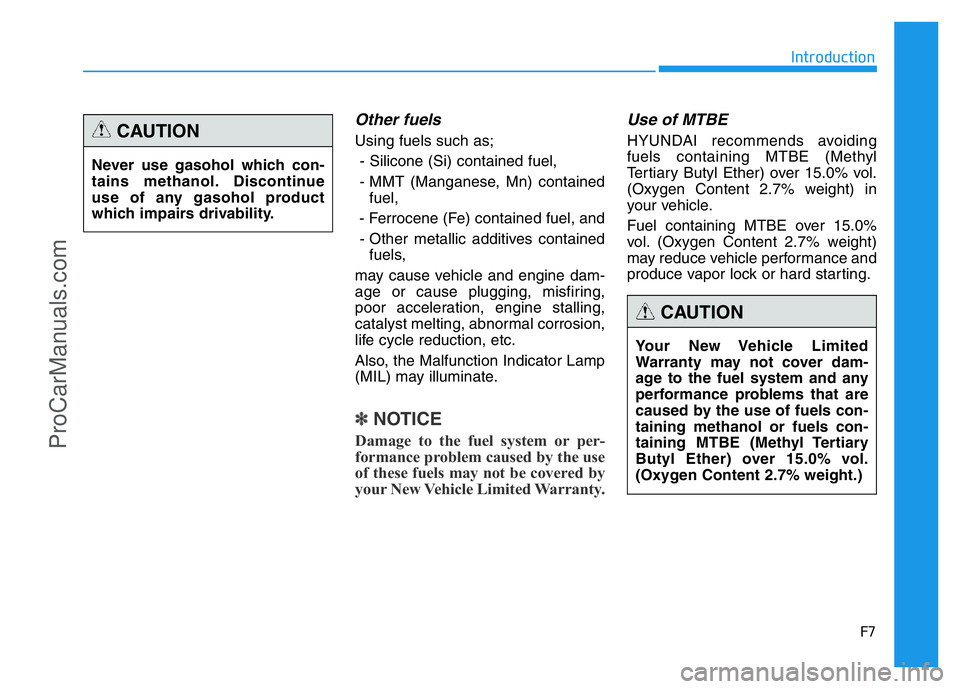
F7
Introduction
Other fuels
Using fuels such as;
- Silicone (Si) contained fuel,
- MMT (Manganese, Mn) contained
fuel,
- Ferrocene (Fe) contained fuel, and
- Other metallic additives contained
fuels,
may cause vehicle and engine dam-
age or cause plugging, misfiring,
poor acceleration, engine stalling,
catalyst melting, abnormal corrosion,
life cycle reduction, etc.
Also, the Malfunction Indicator Lamp
(MIL) may illuminate.
✽ NOTICE
Damage to the fuel system or per-
formance problem caused by the use
of these fuels may not be covered by
your New Vehicle Limited Warranty.
Use of MTBE
HYUNDAI recommends avoiding
fuels containing MTBE (Methyl
Tertiary Butyl Ether) over 15.0% vol.
(Oxygen Content 2.7% weight) in
your vehicle.
Fuel containing MTBE over 15.0%
vol. (Oxygen Content 2.7% weight)
may reduce vehicle performance and
produce vapor lock or hard starting.
Your New Vehicle Limited
Warranty may not cover dam-
age to the fuel system and any
performance problems that are
caused by the use of fuels con-
taining methanol or fuels con-
taining MTBE (Methyl Tertiary
Butyl Ether) over 15.0% vol.
(Oxygen Content 2.7% weight.)
CAUTION
Never use gasohol which con-
tains methanol. Discontinue
use of any gasohol product
which impairs drivability.
CAUTION
ProCarManuals.com
Page 15 of 546
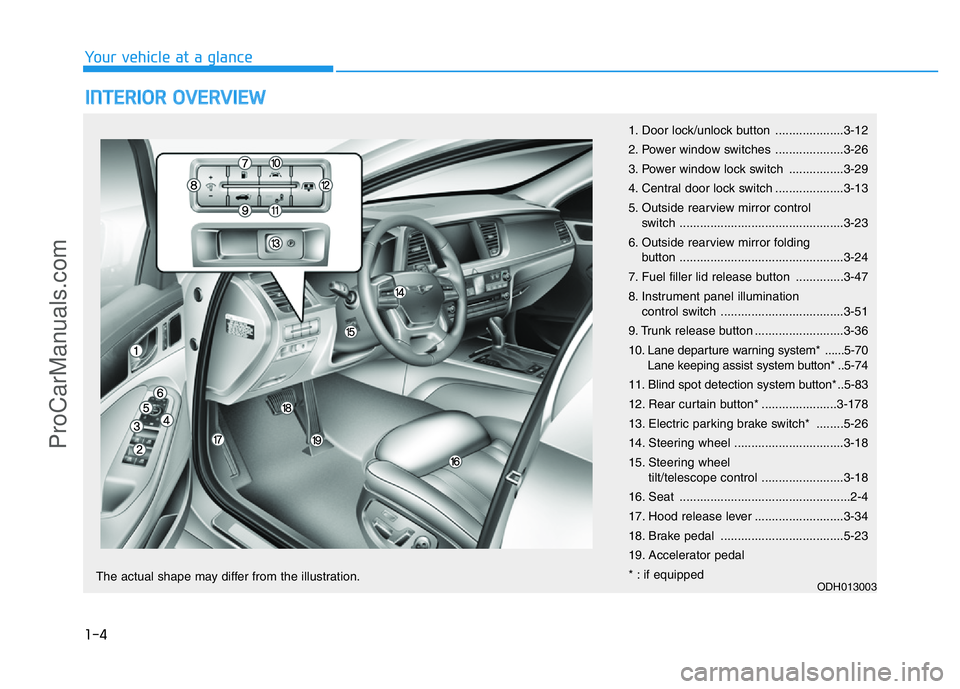
1-4
Your vehicle at a glance
INTERIOR OVERVIEW
1. Door lock/unlock button ....................3-12
2. Power window switches ....................3-26
3. Power window lock switch ................3-29
4. Central door lock switch ....................3-13
5. Outside rearview mirror control
switch ................................................3-23
6. Outside rearview mirror folding
button ................................................3-24
7. Fuel filler lid release button ..............3-47
8. Instrument panel illumination
control switch ....................................3-51
9. Trunk release button ..........................3-36
10. Lane departure warning system* ......5-70
Lane keeping assist system button* ..5-74
11. Blind spot detection system button* ..5-83
12. Rear curtain button* ......................3-178
13. Electric parking brake switch* ........5-26
14. Steering wheel ................................3-18
15. Steering wheel
tilt/telescope control ........................3-18
16. Seat ..................................................2-4
17. Hood release lever ..........................3-34
18. Brake pedal ....................................5-23
19. Accelerator pedal
* : if equipped
ODH013003The actual shape may differ from the illustration.
ProCarManuals.com
Page 22 of 546
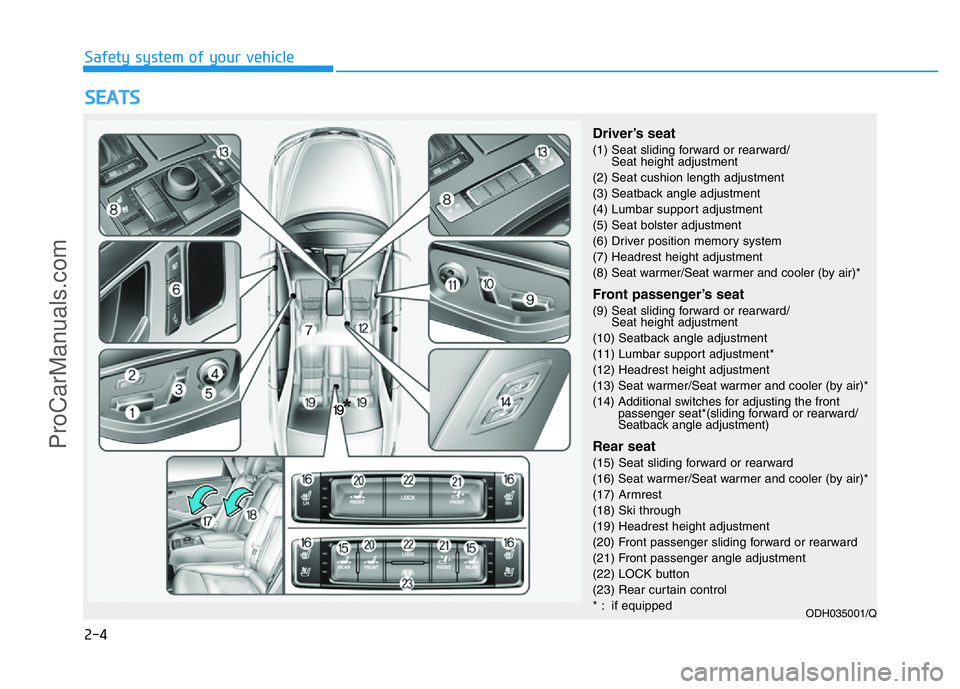
2-4
SEATS
Safety system of your vehicle
Driver’s seat
(1) Seat sliding forward or rearward/
Seat height adjustment
(2) Seat cushion length adjustment
(3) Seatback angle adjustment
(4) Lumbar support adjustment
(5) Seat bolster adjustment
(6) Driver position memory system
(7) Headrest height adjustment
(8) Seat warmer/Seat warmer and cooler (by air)*
Front passenger’s seat
(9) Seat sliding forward or rearward/
Seat height adjustment
(10) Seatback angle adjustment
(11) Lumbar support adjustment*
(12) Headrest height adjustment
(13) Seat warmer/Seat warmer and cooler (by air)*
(14) Additional switches for adjusting the front
passenger seat*(sliding forward or rearward/
Seatback angle adjustment)
Rear seat
(15) Seat sliding forward or rearward
(16) Seat warmer/Seat warmer and cooler (by air)*
(17) Armrest
(18) Ski through
(19) Headrest height adjustment
(20) Front passenger sliding forward or rearward
(21) Front passenger angle adjustment
(22) LOCK button
(23) Rear curtain control
* : if equipped
ODH035001/Q
* *
ProCarManualsйcom
Page 23 of 546
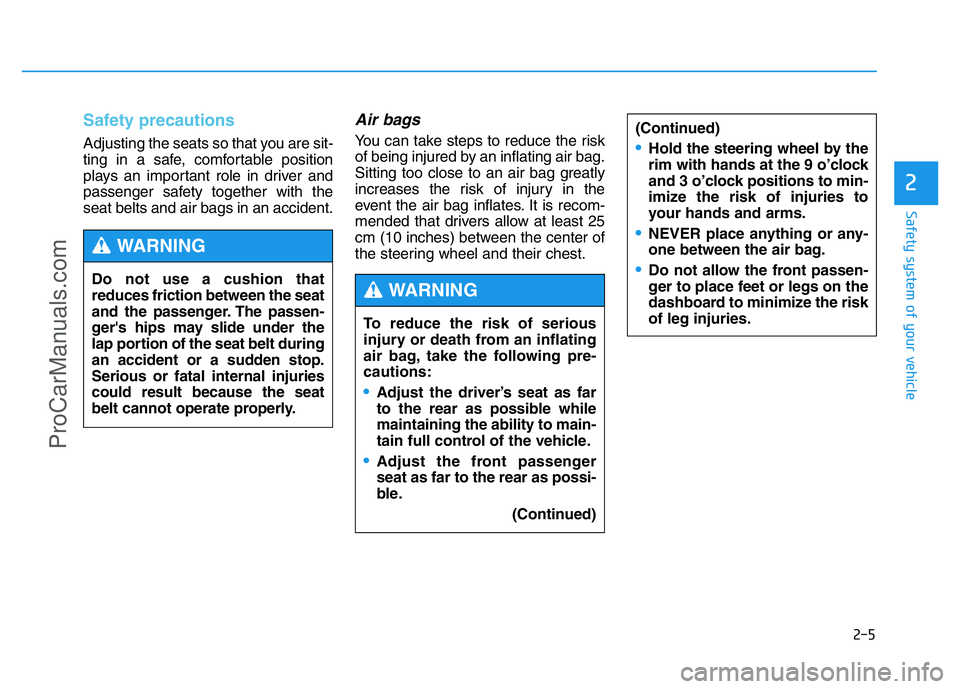
To reduce the risk of serious
injury or death from an inflating
air bag, take the following pre-
cautions:
•Adjust the driver’s seat as far
to the rear as possible while
maintaining the ability to main-
tain full control of the vehicle.
•Adjust the front passenger
seat as far to the rear as possi-
ble.
(Continued)
WARNING
(Continued)
•Hold the steering wheel by the
rim with hands at the 9 o’clock
and 3 o’clock positions to min-
imize the risk of injuries to
your hands and arms.
•NEVER place anything or any-
one between the air bag.
•Do not allow the front passen-
ger to place feet or legs on the
dashboard to minimize the risk
of leg injuries.
2-5
Safety system of your vehicle
2
Safety precautions
Adjusting the seats so that you are sit-
ting in a safe, comfortable position
plays an important role in driver and
passenger safety together with the
seat belts and air bags in an accident.
Air bags
You can take steps to reduce the risk
of being injured by an inflating air bag.
Sitting too close to an air bag greatly
increases the risk of injury in the
event the air bag inflates. It is recom-
mended that drivers allow at least 25
cm (10 inches) between the center of
the steering wheel and their chest.
Do not use a cushion that
reduces friction between the seat
and the passenger. The passen-
ger's hips may slide under the
lap portion of the seat belt during
an accident or a sudden stop.
Serious or fatal internal injuries
could result because the seat
belt cannot operate properly.
WARNING
ProCarManuals.com
Page 25 of 546
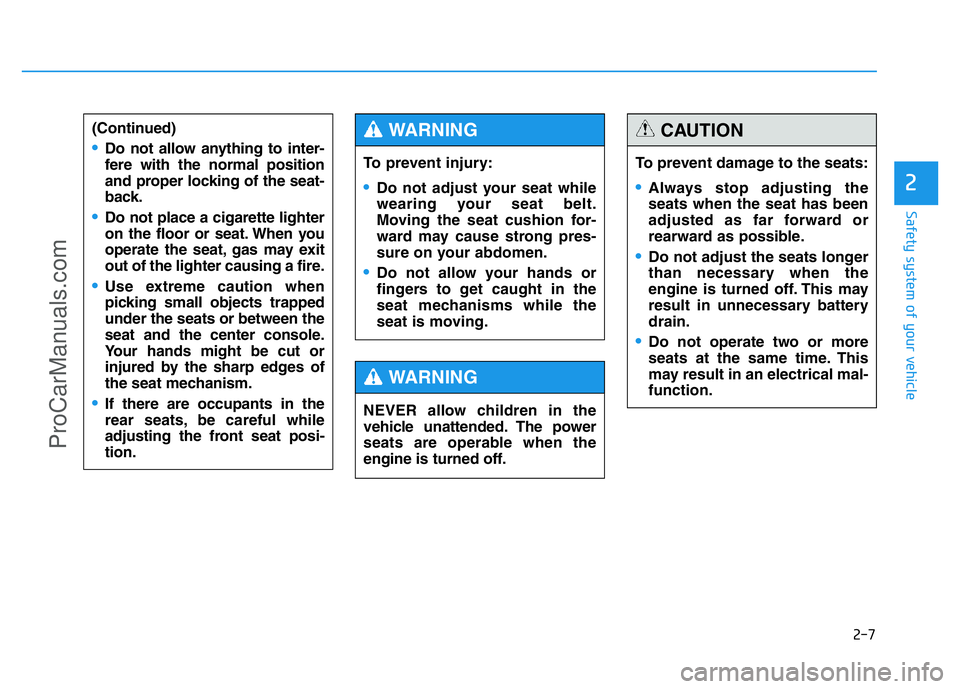
2-7
Safety system of your vehicle
2
To prevent injury:
•Do not adjust your seat while
wearing your seat belt.
Moving the seat cushion for-
ward may cause strong pres-
sure on your abdomen.
•Do not allow your hands or
fingers to get caught in the
seat mechanisms while the
seat is moving.
WARNING (Continued)
•Do not allow anything to inter-
fere with the normal position
and proper locking of the seat-
back.
•Do not place a cigarette lighter
on the floor or seat. When you
operate the seat, gas may exit
out of the lighter causing a fire.
•Use extreme caution when
picking small objects trapped
under the seats or between the
seat and the center console.
Your hands might be cut or
injured by the sharp edges of
the seat mechanism.
•If there are occupants in the
rear seats, be careful while
adjusting the front seat posi-
tion.
To prevent damage to the seats:
•Always stop adjusting the
seats when the seat has been
adjusted as far forward or
rearward as possible.
•Do not adjust the seats longer
than necessary when the
engine is turned off. This may
result in unnecessary battery
drain.
•Do not operate two or more
seats at the same time. This
may result in an electrical mal-
function.
CAUTION
NEVER allow children in the
vehicle unattended. The power
seats are operable when the
engine is turned off.
WARNING
ProCarManuals.com
Page 31 of 546
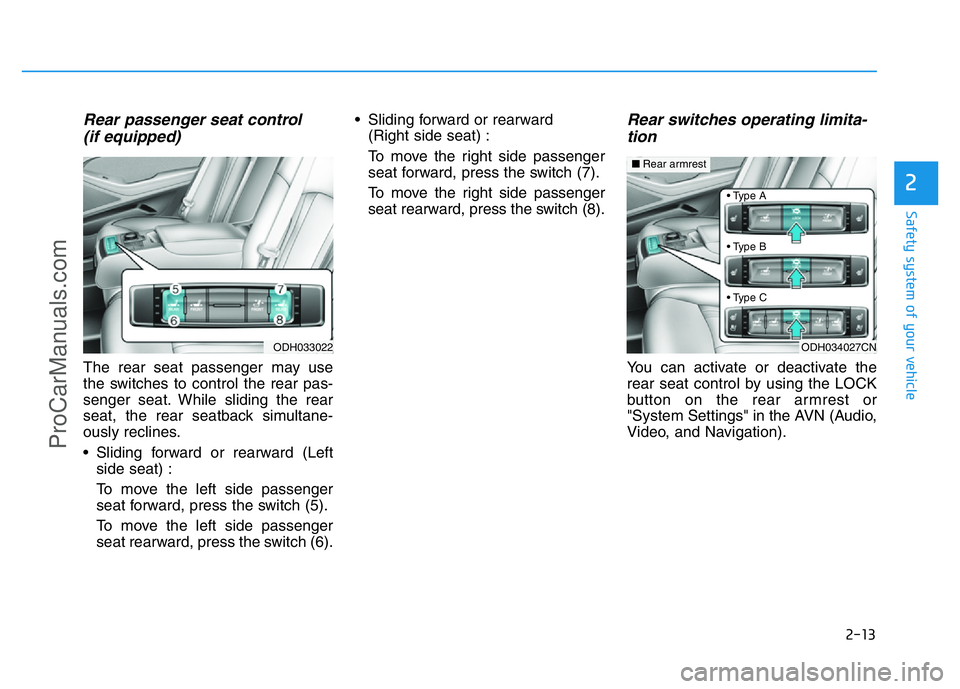
2-13
Safety system of your vehicle
2
Rear passenger seat control
(if equipped)
The rear seat passenger may use
the switches to control the rear pas-
senger seat. While sliding the rear
seat, the rear seatback simultane-
ously reclines.
• Sliding forward or rearward (Left
side seat) :
To move the left side passenger
seat forward, press the switch (5).
To move the left side passenger
seat rearward, press the switch (6).• Sliding forward or rearward
(Right side seat) :
To move the right side passenger
seat forward, press the switch (7).
To move the right side passenger
seat rearward, press the switch (8).
Rear switches operating limita-
tion
You can activate or deactivate the
rear seat control by using the LOCK
button on the rear armrest or
"System Settings" in the AVN (Audio,
Video, and Navigation).
ODH034027CN • Type A
• Type B
• Type CODH033022
■Rear armrest
ProCarManuals.com
Page 32 of 546
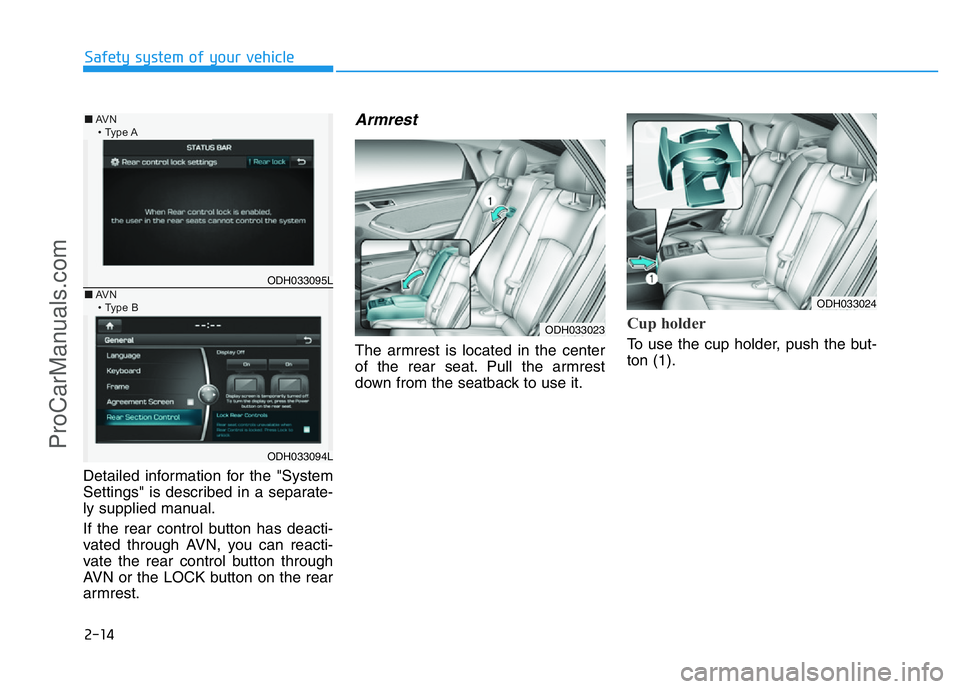
2-14
Safety system of your vehicle
Detailed information for the "System
Settings" is described in a separate-
ly supplied manual.
If the rear control button has deacti-
vated through AVN, you can reacti-
vate the rear control button through
AVN or the LOCK button on the rear
armrest.
Armrest
The armrest is located in the center
of the rear seat. Pull the armrest
down from the seatback to use it.
Cup holder
To use the cup holder, push the but-
ton (1).
ODH033095L
ODH033094L
■AV N
• Type A
■AV N
• Type B
ODH033023
ODH033024
ProCarManuals.com
Page 34 of 546
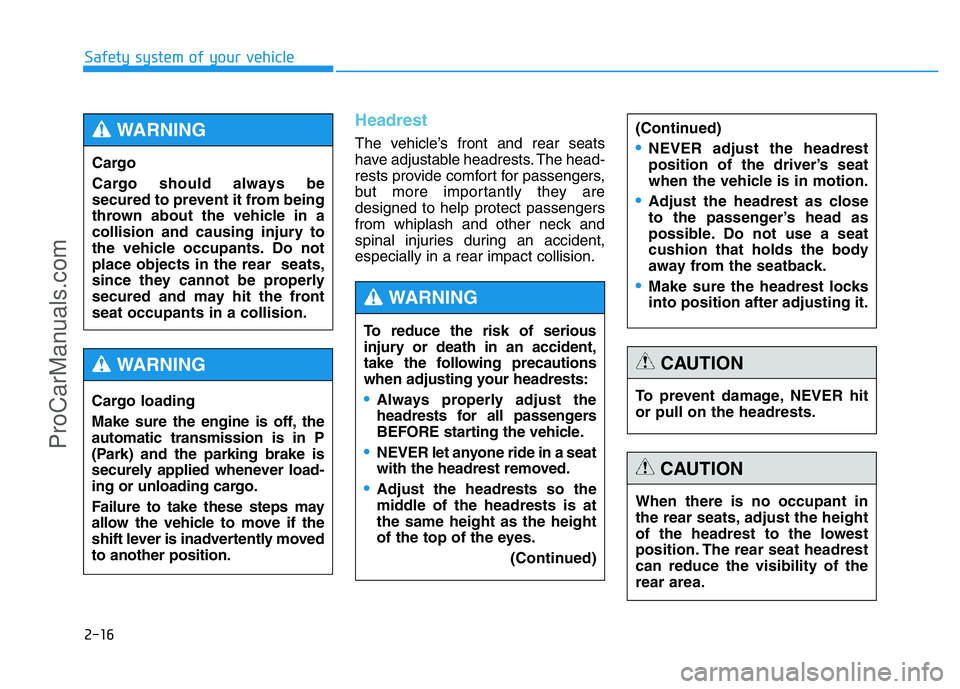
2-16
Headrest
The vehicle’s front and rear seats
have adjustable headrests. The head-
rests provide comfort for passengers,
but more importantly they are
designed to help protect passengers
from whiplash and other neck and
spinal injuries during an accident,
especially in a rear impact collision.
Safety system of your vehicle
To reduce the risk of serious
injury or death in an accident,
take the following precautions
when adjusting your headrests:
•Always properly adjust the
headrests for all passengers
BEFORE starting the vehicle.
•NEVER let anyone ride in a seat
with the headrest removed.
•Adjust the headrests so the
middle of the headrests is at
the same height as the height
of the top of the eyes.
(Continued)
WARNING
(Continued)
•NEVER adjust the headrest
position of the driver’s seat
when the vehicle is in motion.
•Adjust the headrest as close
to the passenger’s head as
possible. Do not use a seat
cushion that holds the body
away from the seatback.
•Make sure the headrest locks
into position after adjusting it.
To prevent damage, NEVER hit
or pull on the headrests.
CAUTION
When there is no occupant in
the rear seats, adjust the height
of the headrest to the lowest
position. The rear seat headrest
can reduce the visibility of the
rear area.
CAUTION
Cargo
Cargo should always be
secured to prevent it from being
thrown about the vehicle in a
collision and causing injury to
the vehicle occupants. Do not
place objects in the rear seats,
since they cannot be properly
secured and may hit the front
seat occupants in a collision.
WARNING
Cargo loading
Make sure the engine is off, the
automatic transmission is in P
(Park) and the parking brake is
securely applied whenever load-
ing or unloading cargo.
Failure to take these steps may
allow the vehicle to move if the
shift lever is inadvertently moved
to another position.
WARNING
ProCarManuals.com
Page 36 of 546
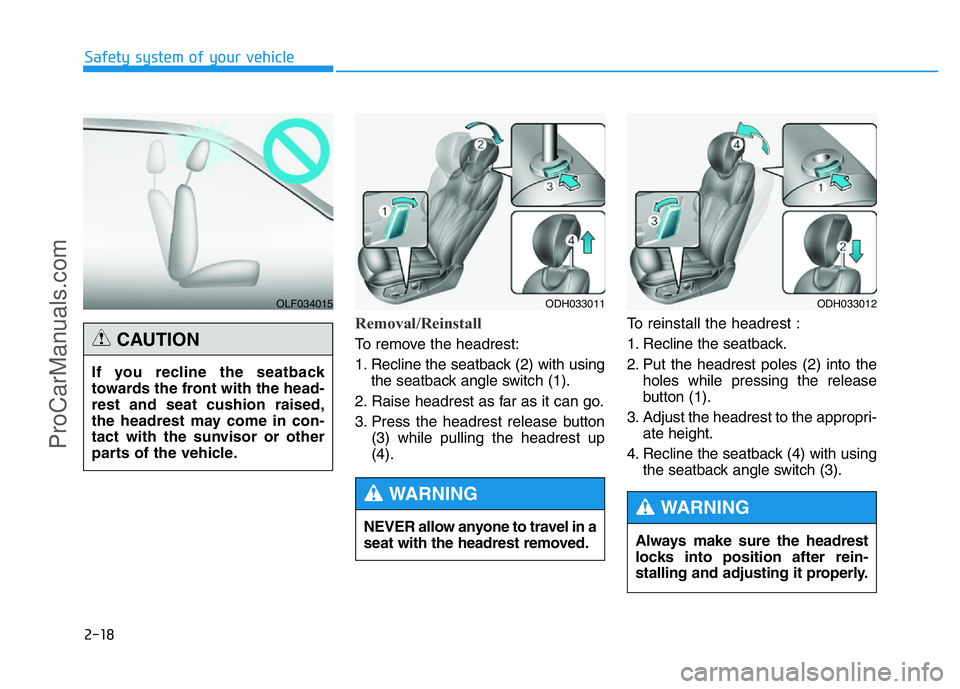
2-18
Safety system of your vehicle
Removal/Reinstall
To remove the headrest:
1. Recline the seatback (2) with using
the seatback angle switch (1).
2. Raise headrest as far as it can go.
3. Press the headrest release button
(3) while pulling the headrest up
(4).To reinstall the headrest :
1. Recline the seatback.
2. Put the headrest poles (2) into the
holes while pressing the release
button (1).
3. Adjust the headrest to the appropri-
ate height.
4. Recline the seatback (4) with using
the seatback angle switch (3).
NEVER allow anyone to travel in a
seat with the headrest removed.
WARNING
ODH033011ODH033012
Always make sure the headrest
locks into position after rein-
stalling and adjusting it properly.
WARNING
OLF034015
If you recline the seatback
towards the front with the head-
rest and seat cushion raised,
the headrest may come in con-
tact with the sunvisor or other
parts of the vehicle.
CAUTION
ProCarManuals.com
Page 41 of 546
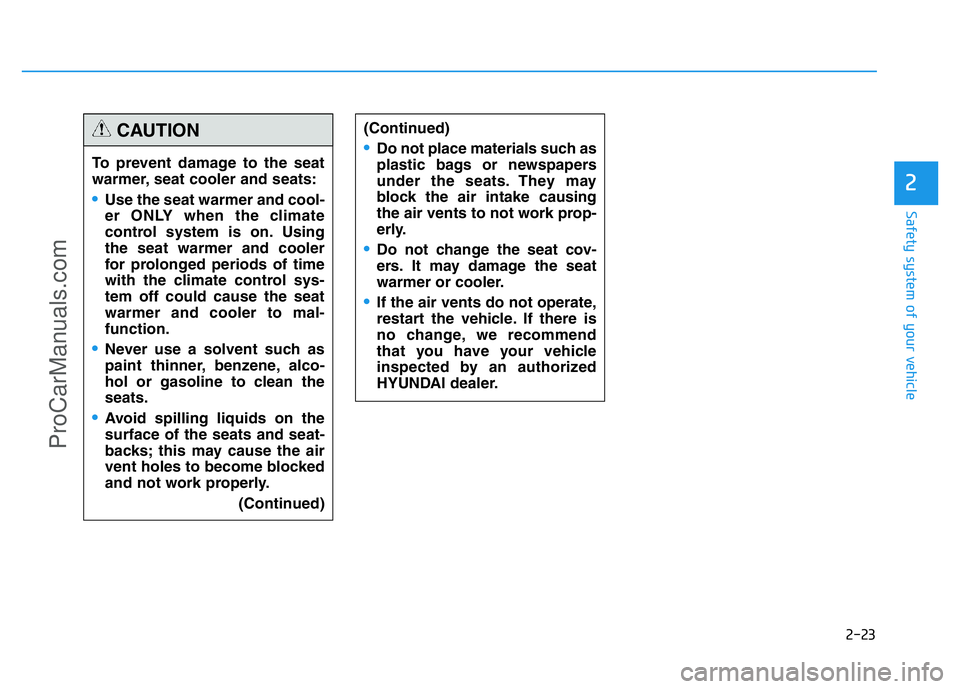
2-23
Safety system of your vehicle
2
(Continued)
•Do not place materials such as
plastic bags or newspapers
under the seats. They may
block the air intake causing
the air vents to not work prop-
erly.
•Do not change the seat cov-
ers. It may damage the seat
warmer or cooler.
•If the air vents do not operate,
restart the vehicle. If there is
no change, we recommend
that you have your vehicle
inspected by an authorized
HYUNDAI dealer.
To prevent damage to the seat
warmer, seat cooler and seats:
•Use the seat warmer and cool-
er ONLY when the climate
control system is on. Using
the seat warmer and cooler
for prolonged periods of time
with the climate control sys-
tem off could cause the seat
warmer and cooler to mal-
function.
•Never use a solvent such as
paint thinner, benzene, alco-
hol or gasoline to clean the
seats.
•Avoid spilling liquids on the
surface of the seats and seat-
backs; this may cause the air
vent holes to become blocked
and not work properly.
(Continued)
CAUTION
ProCarManuals.com